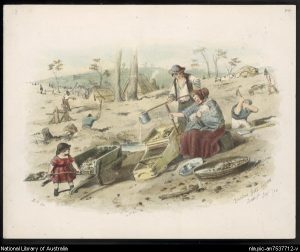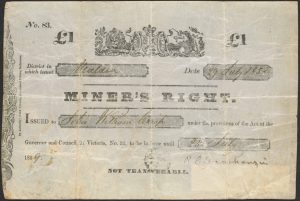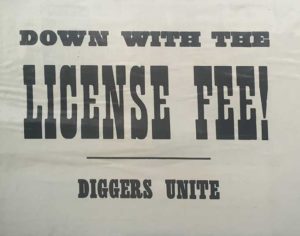 The mists of time have tempered the harsh reality of life on the goldfields, and how the illusion of finding great nuggets of gold lured many young strong men and women to their fortunes an misfortunes. The colony of Victoria separated from New South Wales in July 1851. Soon afterwards the official discovery of gold was reported and the gold rushes began in earnest. They created a population explosion. For example, within three months of gold being found at Ballarat the population increased from around 500-1000 to 20,000 or more. Paper work was still being sorted out between the colonies, and the settlements were in their infancy. There was no supreme court in Victoria until 1852. Registrations of Births, Deaths and Marriages were not compulsory until 1853. The first electoral rolls for the Colony of Victoria were printed in 1855.
The mists of time have tempered the harsh reality of life on the goldfields, and how the illusion of finding great nuggets of gold lured many young strong men and women to their fortunes an misfortunes. The colony of Victoria separated from New South Wales in July 1851. Soon afterwards the official discovery of gold was reported and the gold rushes began in earnest. They created a population explosion. For example, within three months of gold being found at Ballarat the population increased from around 500-1000 to 20,000 or more. Paper work was still being sorted out between the colonies, and the settlements were in their infancy. There was no supreme court in Victoria until 1852. Registrations of Births, Deaths and Marriages were not compulsory until 1853. The first electoral rolls for the Colony of Victoria were printed in 1855.
The situation was unique and the task mammoth. The government was stretched to the limit to provide the services required but needed to pay its servants. It decided that the way forward was in the form of taxation through licences. The number of Gold Licenses issued is problematical. Printed licences ran out on the Ballarat Goldfields in August 1851 and the officials had then to write them by hand. There appear to be no centralised records that list miner’s licences, so that hunting for an ancestor who was an early gold seeker can sometimes be extremely difficult.
Administration of the goldfields was based on a series of Goldfields Acts dating from 1853 when an Act for the better management of the Goldfields, 17 Vic., No.4, was passed. This Act provided for a system of mining leases and licences to be administered by the Commissioners of Crown Lands, who were also known as Goldfields Commissioners. Earlier legislation (e.g. the 1851 and 1852 Acts 15 Vic., No.15 and 17 Vic., No.1) had made provision for the Commissioners to regulate mining on “waste lands of the Crown”. In 1855 the licensing system introduced in 1853 was replaced by a system of miners’ rights administered by local courts which operated in designated districts, and had similar powers to a Court of Petty Sessions (18 Vic., No.37). Members of the courts were elected by holders of miners’ rights in the district. These arrangements were further refined by the 1857 Act 20 Vic., No.32 which set up a more complex administrative and judicial structure within specified Mining Districts comprising Mining Boards, Mining Wardens and Courts of Mines. NOTE: For more information about the history of this function, see Public Record Office Victoria, VRG 30 Mines. For records of Mining Districts, see VRG 25.

License no. 144. Issued to George Bencraft on 5 February 1853 by Commissioner R. Crespigny. State Library of Victoria Collection (H41033/19)
1851
REGULATIONS TO BE OBSERVED BY THE PERSONS DIGGING FOR GOLD OR OTHERWISE EMPLOYED AT THE GOLDFIELDS,
1 This License is to be carried on the person, to be produced whenever demanded by any commissioner, peace officer, or other duly authorised person, and is not transferable.
2 No Mining will be permitted where it would be destructive of any line of road which it is necessary to maintain, and which shall be determined by any Commissioner, nor within such distance around any store as it may be necessary to reserve for access to it.
3 It is enjoined that all persons on the Gold Fields maintain a due and proper observance of Sundays
4 The extent of claim allowed to each Licensed miner is twelve feet square, or 144 square feet.
5 To a party consisting of two Miners, twelve feet by twenty-four, or 288 square feet.
6 To a party consisting of three Miners, twenty-four feet by twenty-four, or 576 square feet: beyond which no greater area will be allowed in one claim.
Printed by John Ferres, at the Government Printing Office. [VPRS 1095/P0, Special Files, Unit 2, Bundle 0, No. 10]
1852
In 1852 the regulations printed onto the license were:
1. Every licensed person must always have his License with him ready to be produced whenever demanded by a Commissioner, or Person acting under instructions, otherwise he is liable to be proceeded against as an unlicensed person.
2. Every person digging to Gold, or occupying Land, without a License is liable by law to be fined, for a first offence, not exceeding five pounds; for a second offence not exceeding 15 pounds; and for subsequent offence, not exceeding 30 pounds.
3. Digging for Gold is not allowed within ten feet of the edge of any Public Road, nor are the roads to be undermined.
4. Tents or Buildings are not to be erected within twenty feet of each other, or within 20 feet of any Creek
5. It is enjoined that all persons on the Gold Fields maintain a due and proper observance of Sundays.
1854
In 1854 the regulations on the license were:
1. This license is to be carried on the person and produced whenever demanded by any Commissioner, Peace Office, or other duly authorised person, and is not transferable.
2. No Mining will be permitted where it would be destructive of only line of road which it is necessary to maintain, and which shall be determined by any Commission, nor within such distance around any store as it may be necessary to reserve for access to it.
3. It is enjoined that all persons on the Gold Fields maintain a due and proper observance of Sundays.
4. The extent of claim allowed to each Licensed Mine is twelve feet square, or 144 square feet.
5. To a party consisting of two Miners, twelve feet by twenty-four, or 288 square feet.
6. To a party consisting of three Miners, eighteen feet by twenty-four, or 432 square feet.
7. To a party consisting of four Miners, twenty-four feet by twenty-four, or 579 square feet : beyond which no greater area will be allowed in one claim.
Gold License Fees
A Victorian Gold License cost 30 shillings per month (or one pound ten shillings for two months). In 1854 it was possible to purchase a gold license for a three month period for two pounds. There were also storekeeper’s licenses and liquor licenses that were more expensive than the gold license.
The Miner’s Right

Miner’s Right, Issued to John William Crisp, 29 July 1858 and valid for one year in the district of Maldon. State Library of Victoria.
Resulting from a report from the Royal Commission, the Gold License was replaced with the Miner’s Right on the first of May 1855, the first Miner’s Right being issued in June 1855. It cost £1 per annum. By the end of July 1855, around 30,000 Miner’s Rights had been issued, a total that rose to 50,000 by the end of the year.
The Third Goldfields Act was passed on 12 June 1855. It was after this that a miner in possession of a Miner’s Right could dig for gold, and had the right to take a parcel of land and erect a cottage on it with garden. It also gave him the right to graze animals on a Goldfields Common and on vacant Crown Land.
The fourth Goldfields Act was passed in early 1858. This Act gave the owner the right to make residential claims, giving more authority to those that paid for the Miner’s Right. Local Courts were replaced by a combination of a Court of Mines and elected Mining Boards.
Under the Mining Statute of 1865 the Miner’s Right could be issued for up to 15 years. One quarter of an acre of crown land could be occupied for residential purposes. Timber of Crown land could be cut for fuel and timber, stone and other material on Crown land could be used for building and mining purposes. The residential claim was vitally important in the development of Victoria’s gold-mining towns where a remarkably high proportion of residents were owner occupiers.
Much of the land in the Ballarat and Ballarat East districts were held under Miner’s Right until recently. The registers of land residence areas, held at the Public Record Office, Ballarat Archive Centre, show the entries for land leased under this scheme. The registers are under the following series numbers: VPRS 5448 Index 1883-1936; VPRS 6165 1864-1975; and VPRS 575 Rent roll- mainly farming.
A Miner’s Rights Collection is held by the Gold Museum, Ballarat. It consists of 298 Miner’s Right Certificates issued in Victoria between 1857 and 1971. Of these 183 are from the Ballarat area and the remainder come from various locations in the state. Some documents are held by various libraries and other associations.
